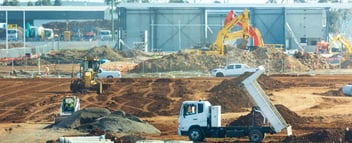13 fleet truck fuel management best practices
Fuel is the second-largest fleet-operating expense year after year. On average, it eats up 60% of a company’s total fleet operating budget, which makes tracking and managing fuel consumption a must for fleet operators.
While it’s true that you’ll never be able to predict or change the cost per gallon because crude oil prices are always changing and your company will always have certain operational minimums that it has to maintain, it’s important to realize that many of the factors that influence fleet fuel spending are within your control.
With Tread’s fleet management software, you can start to analyze the activities that impact fleet fuel consumption. With access to detailed reporting and mileage information, you can address the daily decisions to improve bottom-line spending.
We’ve turned these budget-fueling factors into 13 fuel and fleet management best practices, and we’ve outlined them all below. If cutting fuel costs is your fleet’s main priority right now, these 13 simple steps will help get you there.
Tread’s paperless construction fleet management solution can help you cut costs and increase fuel efficiency. Request a demo today.
How do you manage fuel for the fleet?
The best way to manage fleet fuel costs is to create a fuel management system, and the best solution to create a fuel program like this is by using fleet management software.
Using software to manage your fleet gives you clear, accurate, and actionable statistics. Tracking vehicle mileage, maintenance needs, and average speed helps to inform you of which vehicles, drivers, and routes are most fuel-demanding. Since you can only improve what you measure, this data is a crucial part of monitoring and, ultimately, reducing fleet fuel costs.
Tip for Fleet Managers:
If the idea of more data entry has you wincing, don’t panic. Tread’s fleet management software lets you digitize manual tracking. It’ll give you all the data-based insights you need to combat fuel prices and record driver behaviour, saving both time and money.
1. Source cheaper fuel
We realize that if reducing operating expenses was as simple as sourcing cheaper fuel, everyone would be on-budget! But, if you haven’t looked for ways to save on gas prices in awhile, it’s worth taking the time to do so.
Fleet Management Tip:
To save money, some fleets are using mobile fueling, where a cost-effective supplier brings fuel directly to the fleet. This can help reduce unplanned stops and unnecessary fuel-ups. It can also simplify expense tracking by reducing the number of different gas prices you’ll need to track throughout the year.
2. Upgrade to fuel-efficient vehicle models
If upgrading any of your fleet’s vehicles is an option for you, it’s one worth considering. New models, especially those that use alternative fuels, hybrids, and models designed for fuel efficiency, have higher mile per gallon ratings than their older counterparts. More miles per gallon means less fuel overall!
Fleet Management Tip:
If it’s not time for your fleet to upgrade yet, don’t worry. Just by following normal replacement cycles, you can expect to see an improvement in both miles per gallon and costs per mile over time.
3. Right-size your fleet
Growing and scaling is hard, which is why it’s actually quite common for fleets to have either too many or too few vehicles. Strategically evaluating your fleet’s size and workload should highlight any inefficiencies, helping you cut back on expenses where you can. Look for opportunities to reduce the number of vehicles in your fleet, or to make the vehicles you have more efficient with route-mapping.
Fleet Management Tip:
Fleet management software can make right-sizing your fleet much easier. It offers robust data and reporting that lets you better understand both your efficiencies and your inefficiencies.
4. Schedule vehicle maintenance
If you’re looking to save money on fleet fuel, don’t skip regular vehicle maintenance. In fact, we recommend scheduling proactive maintenance to ensure that your fleet is always in tip-top shape.
Something as simple as wheel misalignment can reduce the efficiency of a vehicle, meaning it will require more fuel in order to run well. And, regular services will help you keep maintenance costs to a minimum.
Read more: Why construction equipment maintenance matters. Learn how to prepare an effective maintenance program.
5. Keep vehicles clean
Dirt, oil, salt, and other types of build up can add weight to a vehicle— especially large vehicles, heavy duty trucks, and haulers. Unwashed vehicles are less efficient, not just because they’re heavier, but also because the buildup can create friction and drag. (More on the impacts of drag below.)
Fleet Management Tip:
Take extra care to clean your fleet, especially during the winter, when snow and ice become caked-on quickly.
6. Check tire pressure
According to the US Department of Energy, you can improve your gas mileage by 0.6% to 3% simply by properly inflating your tires. Their research indicates that under-inflated tires can lower mileage by 0.2% for every 1 PSI drop in the average pressure of your tires. This means that simply maintaining proper tire pressure could save you up to $0.01 per gallon!
7. Reduce drag
Haulers and dump trucks are massive, so they consume a ton of fuel. And whether or not a mammoth vehicle like this is aerodynamic has a huge impact on its overall fuel consumption. In fact, drag alone can waste as much as half of a truck’s total fuel. For large truck fleets, that’s a huge budget consideration.
Fleet Management Tip:
To make your heavy duty trucks as fuel-efficient as possible, regularly assess all aerodynamic devices. Make sure you minimize any gaps between the tractor and the trailer, and monitor tire pressure consistently.
Want to go above and beyond? Consider side skirts: panels that cover the length of the truck and serve to enclose any open spaces between tires. Side skirts are said to improve fuel efficiency by up to 5%!
8. Use driver fuel cards
A controlled fuel card program makes in-house fleet fuel management much easier. By monitoring fuel purchases, a driver fuel card gives you more control over employee spending by setting limits around things like:
- Which stations drivers visit
- How often drivers fuel up
- What times of day fuel can be purchased
- How much fuel is pumped per visit
These cards also provide you with data and reports, which you can use to limit undue spending and prevent driver fuel card fraud.
9. Track driver habits
If you work in fleet dispatch, you already know that distracted driving, reckless driving, idling, and personal stops all have major, negative effects on fleet productivity and overall safety. But things like starting and stopping, speeding, and unplanned detours are all major culprits when it comes to fuel inefficiency, too.
Great fleets and happy clients depend on good drivers, and if you have a goal of improving driver behaviour, your first order of business should be to start tracking driver habits. Much like fuel prices, when it comes to habits, you can’t change what you don’t measure.
The best way to track employee driving is to use fleet management software, like Tread. With super-accurate GPS technology, it will give you reliable, real-time data about each of your drivers. It will also help you hold your drivers accountable by giving you objective facts to base staffing and training recommendations on.
Fleet Management Tip:
When you track driving habits, you can start to implement and enforce safety strategies with your drivers. Things like observing speed limits, staying on-route, and reducing idling.
10. Respect the speed limit
Observing the speed limit isn’t just a safety issue — it can have a major effect on fuel economy, too. In fact, the US Department of Energy reports that after a driver reaches 50mph, gas mileage quickly starts to decrease. They even go so far as to say that each 5 mph you drive over 50 mph is like paying an additional $0.15 per gallon for gas!
11. Limit engine idling
There are two main types of idling: non-discretionary and discretionary. Discretionary idling occurs when drivers are resting. It’s often used to help keep sleeper compartments at the right temperature. Non-discretionary idling happens when a vehicle is caught in bad traffic.
Most fleets will experience a mix of both types of idling which, when it comes to fuel waste, is a significant consideration. Good fleet management software will help you track statistics like hours spent idling and miles driven, to help you increase productivity and improve fuel management.
Fleet Management Tip:
By limiting both types of idling, it’s estimated that the average fleet could save up to $6,000 per truck, per year.
12. Map efficient routes
Efficient routes improve mileage and fleet productivity. By combining trips with similar routes, you can eliminate unnecessary stops. Efficient routes can also help your drivers dodge traffic jams and, of course, they improve fuel efficiency.
Pro Tip: Tread can help you identify gaps or conflicts in drivers’ schedules to help you plan the most efficient schedules.
13. Use fleet management software
More and more fleets are employing fleet management software to help automate data entry and capture accurate, real-time data without fuss.
Fleet management software can save you operating costs by reporting on driver behavior, tracking idling hours, helping you plan efficient driver schedules, and monitoring unplanned routes or personal stops.
Save money and fuel with Tread
If you’re looking to cut costs and increase fuel efficiency, start with Tread.
Tread makes fleet growth fast, easy, and on-budget. We are digitizing the construction industry — making data management and other traditionally manual tracking methods automatic and error-free. And we make both construction fleet management and truck dispatch management easier and more efficient than ever. Request a demo today!
Read On

What Is Construction Fleet Management?
Managing a construction company comes with many challenges. Some of the most common issues include...

Construction fleet management key performance indicators
Tracking Key Performance Indicators is important to understand a business’s health and performance....

Top 7 Responsibilities of a Construction Fleet Manager
Companies both in and and outside the construction industry often use mobile workforces and vehicle...

